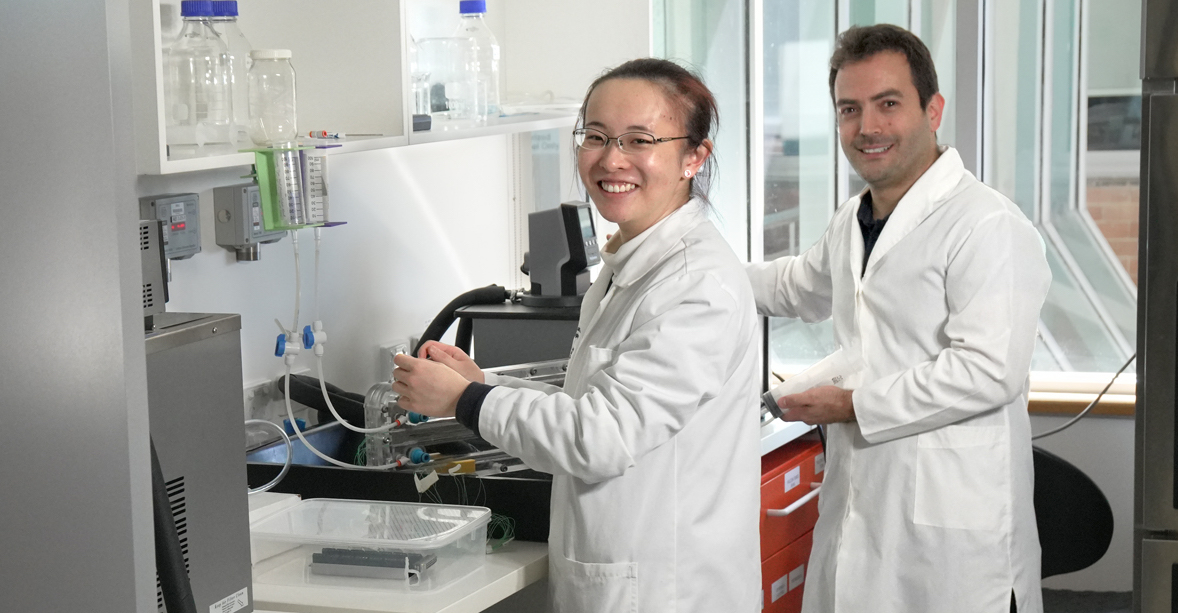“It’s exciting to see a phenomenon that no one has seen before,” said Ms Shuqi Xu, a PhD candidate at the Australian National University (ANU).
“I don’t want people to think I am a workaholic, but I often come to the lab on Sundays. I can’t wait to find out the results of our experiments.”
Ms Xu’s dedication has contributed to the advent of the world’s first thermal desalination method where water remains in liquid phase throughout the process. The power-saving, potentially lifesaving new approach is outlined in a new study published in Nature Communications.
Confluence of interests
“Severe drought is happening more often due to climate change,” Ms Xu said.
“Optimising water desalination is our best hope to prevent famine caused by lack of water for agriculture.”
Ms Xu first became impassioned about water security as an undergraduate when, as part of a Humanitarian Engineering program offered in partnership with Engineers Without Borders, she visited a remote island on the Mekong River in Cambodia.
“People got skin rashes if they bathed in the river,” she recalled. “They relied on collecting rainwater to have enough to drink. After seeing this, I really wanted to pursue a career where I can make a difference in people’s lives.”

The course lecturer, Dr Juan Felipe Torres, is a world-leading researcher who established the ANU Heat for Environmental and Aerospace Technologies (HEAT) Lab.
“I was impressed that he was able to explain complex things with both clarity and depth,” Ms Xu said. “I also liked the course design, including the homework and exams, which made me think about the underlying mechanisms and assumptions behind a question.”
When it came time to pursue her Honours research, Ms Xu sought out Dr Torres as a supervisor. After earning her degree, she joined his lab as a PhD student.

“My motivation to research thermodiffusion for my PhD had a lot to do with my supervisor,” she said of Dr Torres. “He is really motivated to use technology to help people, and I had already learned a lot from him. So, I knew it would be a good experience working with him.”
Ms Xu is the first author and Dr Torres is the Lead Chief Investigator on the Thermodiffusive desalination paper.
Race against time
Globally, more than 70 per cent of freshwater resources are used for agriculture.
As the global population surpasses sustainable limits, agriculture and other vital industries such as textiles and meat production will need more water to keep up.
“Our freshwater resources are already under a lot of strain,” said Dr Torres. “When we add to that the impacts of climate change and longer and more severe periods of drought, we could be facing compounding humanitarian crises.”
Current desalination technologies require large amounts of energy, and expensive materials that need to be serviced and maintained. They perform well in urban and industrialised regions but are not as sustainable in developing nations or in rural and remote areas.
“If we continue fine-tuning the current technology without changing the fundamentals, it might not be enough,” Dr Torres said. “A paradigm shift is essential to ensure we can sustain human life over the next century.”
The new research proposes the global distribution of simpler, smaller, more affordable desalination units triggered, not by electricity, but by low-grade heat generated directly from sunlight, or from excess heat created during industrial processes.
Elegance of simplicity
The phenomenon behind this technology, called thermodiffusion, has been known since the 19th century:
“If you have a bucket of salty water and one part of the water is colder and one part is hotter, the sodium chloride will move to the cold side,” Ms Xu explained.
To test whether this effect can be used for water desalination, researchers pushed seawater through a narrow channel heated from above to 60°C and cooled from below to 20°C.
Once the salt had migrated to the cooler water, the device re-processes the warmer, fresher water through the channel again while the cooler, saltier water was removed.
Each time the water passed through the channel, its salinity was reduced by 3 per cent. The research shows that after repeated cycles, the salinity of seawater can be reduced from 30,000 parts per million to less than 500.

They are now developing a multi-channel device to be deployed in Tonga, where severe drought has hurt agriculture yields and made water scarcity an ongoing concern.
HEAT Lab researchers are excited about the new method because it does not require the presence of an electrical grid. The Tonga facility will be powered by a solar panel “no bigger than my face”, Ms Xu said.
“There are thousands of remote regions, and dozens of small countries around the world facing water scarcity,” Dr Torres said. “They are in the places where climate change is having the worst impacts, drying their land and destroying their agriculture. We need thermodiffusive desalination to decentralise the process and sustainably bring water security these regions.”
More about the Humanitarian Engineering Minor at ANU:

